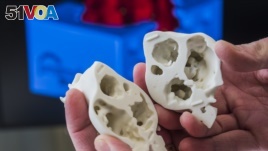25 January, 2015
51VOA听写整理,转载请注明出处。文本仅供参考,欢迎纠错!
From VOA Learning English, this is the Technology Report.
Researchers are now using three-dimensional, or 3D printing to create models of the human heart to help heart specialists. The heart doctors can use the models to better help patients before an operation.
Surgeons regularly use digital images to explore the heart in close detail. But no two human hearts are alike. This led Matthew Bramlet to create exact heart models from those images. Dr. Bramlet is a pediatric or children's heart expert at the University of Illinois College of Medicine. He says the 3-D models show information he cannot get any other way.

3D-printed model adds new dimension to heart surgery, allowing surgeons to see defects that might not be readily apparent in digital images. (James Carlson, Saint Francis Medical Center)
"Even when I will take the MRI and render the images, even a print heart that is sort of spinning on the screen, it's still a 2-D screen. And so what we've done with the printed models, we've pulled it out of the screen so that you can actually hold it in your hand and evaluate the anatomy for the first time in a manner that makes sense and is logical."
A 3-D printer uses images from a digital display to create a physical model of a human heart. Matthew Bramlet says doctors can use the model, in his words, "to understand the anatomy for the first time."
Pictures from medical tests like CAT scan or MRI are sent to a 3-D printer to create a heart in a plaster or clay form. The printer then constructs the heart, thin layer by thin layer. Dr. Bramlet says the model matches the real heart in every detail. "When we're done with the model and made our decision, we want to be able to go back to the source image and confirm those findings," he says.
Dr. Bramlet has built model hearts for different kinds of heart operations. All of the operations were successful. In his first case, digital images showed only one tiny hole in a baby's heart. But, the 3-D printed model showed several defects or problems that the baby was born with. Dr. Bramlet says those defects could not be seen easily in the images. The heart surgeon was able to change the type of surgery for the patient based on the 3-D model. He added that 3-D heart models saves time during heart operations.
Kathy Magliato is a cardiac surgeon at Saint John's Health Center in Los Angeles. She welcomes the new technology. She says it could help her make better decisions before she operates on the hearts of her patients.
"The fact that I can then take this very complicated structure, which has endless possibilities of what it could look like anatomically when I open the body, and you give it to me before the operation and I can hold it in my hand and plan an operation around what I'm seeing, touching and feeling. That to me is what can potentially change the game in an operation and save lives."
Matthew Bramlet continues to research the technology. He is working with the National Institutes of Health to build a 3-D library that includes heart models and images that others can use.
I'm Jonathan Evans.